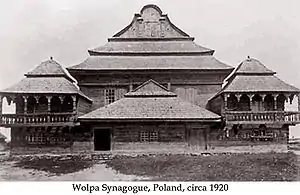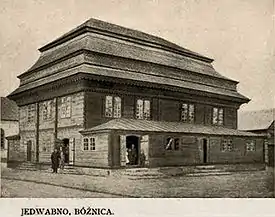Wooden synagogues of the former Polish–Lithuanian Commonwealth
Wooden synagogues are an original style of Synagogue architecture that developed in the Polish–Lithuanian Commonwealth.[1][2] The style developed between the mid-sixteenth and mid-seventeenth centuries, a period of peace and prosperity for the Polish-Lithuanian Jewish community. While many were destroyed during the First and Second World Wars, there are some that survive today.
Uniqueness as an artistic and architectural form
The wooden synagogue was "an original architectural genre" that drew on several models, including Poland's wooden building traditions and central plan, masonry synagogues in which four massive masonry pillars that define the Bimah rise to support the roof vaulting.[3] Central pillars support the vaulting of only a handful of wooden synagogues. Instead, in wooden synagogues the vaulting and domes are suspended by elaborate roof trusses. Common features shared by wooden synagogues include the independence of the pitched roof from the design of the interior domed ceiling. The outside of a wooden synagogue gave no hint of the domes and multiple, Baroque vaults that would be found within. The exteriors were decidedly plain, giving no hint of the riot of carving, painting, domes, balconies and vaulting inside. The architectural interest of the exterior lay in the large scale of the buildings, the multiple, horizontal lines of the tiered roofs, and the carved corbels that supported them. The elaborate domed and vaulted ceilings were known as raki'a (Hebrew for sky or firmament) and were often painted blue sprinkled with stars. The Bimah was always placed in the center of the room. Wooden synagogues featured a single, large hall. In contrast to contemporary churches, there was no apse. Moreover, while contemporary churches featured imposing vestibules, the entry porches of the wooden synagogues was a low annex, usually with a simple lean-to roof. In these synagogues, the emphasis was on constructing a single, large, high-domed worship space.[1][2][3][4]
According to art historian Stephen S. Kayser, the wooden synagogues of Poland with their painted and carved interiors were "a truly original and organic manifestation of artistic expression—the only real Jewish folk art in history".[5]

According to Louis Lozowick, writing in 1947, the wooden synagogues were unique because, unlike all previous synagogues, they were not built in the architectural style of their region and era, but in a newly evolved and uniquely Jewish style, making them "a truly original folk expression", whose "originality does not lie alone in the exterior architecture, it lies equally in the beautiful and intricate wood carving of the interior".[6]
Moreover, while in many parts of the world Jews were proscribed from entering the building trades and even from practicing the decorative arts of painting and woodcarving, the wooden synagogues were actually built by Jewish craftsmen.[7] Other research points to certain synagogues being made by Christian master builders. For example, the early history of the Gwoździec Synagogue is unknown and portions of the structure date back to 1650. The original structure was built in a regional style exhibiting both Jewish and Polish vernacular architecture. In the 18th century there was a dramatic reconfiguration of the prayer hall ceiling. It is believed to be the first cupola of its kind. The timber framers are unknown but presumed to be Christian master builders since until the 19th century Jews were excluded from the trade. The liturgical paintings were made by Jewish artists. Isaac, son of Rabbi Judah Leib ha Cohen and Israel, son of Rabbi Mordecai, have inscribed their names on the paintings in the western ceiling.[8][9]
The interior vaulting of the Wolpa Synagogue is described by art historians Maria and Kazimierz Piechotka as having been "the most magnificent of all known wooden ceilings" in Europe.[10] Of course, since Christians were free to build with brick and stone, few European buildings of the scale of the Wolpa synagogue were ever built in wood. The walls of the main hall were 7.2 meters high. The vaulting, under a three-tiered roof, rose to a height of fourteen meters in three tiers marked by fancy balustrades. Each tier was made up of several curving sections faced in wooden paneling to form a graceful, tiered and vaulted dome. The vaulted ceiling was supported by the four wooden corner columns that rose form the bimah, and by trusses in the roof.[11]
Art historian Ori Z. Soltes points out that the wooden synagogues, unusual for that period in being large, identifiably Jewish buildings not hidden in courtyards or behind walls, were built not only during a Jewish "intellectual golden age" but in a time and place where "the local Jewish population was equal to or even greater than the Christian population".[12]
History

According to Maria and Kazimierz Piechotka, the wooden synagogue style developed in the century between the mid-sixteenth and mid-seventeenth centuries, a period of peace and prosperity for the Polish-Lithuanian Jewish community. In addition to Poland and Lithuania, wooden synagogues are found in modern Belarus and Ukraine.
Wood was abundant and inexpensive in the heavily forested commonwealth, but a large part of the motivation for building in wood rather than masonry was the great difficulty of obtaining government permission to erect masonry synagogues.[13] The wooden synagogues, which featured multi-layered high roofs, multi-beamed domes, galleries, wooden balconies and arches were built to high standards of craftsmanship.[14]
Interior decoration
The interiors were decorated with wall and ceiling paintings that, in many cases, covered the walls and ceilings entirely, and with elaborately carved wooden Torah arks.[3][4][14]
Thomas Hubka has traced the style of decorative painting in the wooden synagogues to the medieval Hebrew illuminated manuscripts of Ashkenazi Jewry.[15]
The intricate wooden decoration of the barrel vaulted ceiling of the Przedbórz Synagogue was considered so beautiful that before the Second World War it drew tourists to the small village of Przedbórz.[16]
Regional variations
Architectural historian Rachel Wischnitzer has traced regional variations in wooden synagogue style. The interiors of the wooden synagogues of Lithuania were not as exuberantly painted as were synagogues of other regions. Instead, Lithuanian synagogues were notable for architectural details such as ceilings with the boards laid in decorative herringbone patterns. Several Lithuanian synagogues featured corner pavilions. The wooden synagogues of Galicia were notable for their elaborate wall paintings.[1]
Influence on art and architecture
Frank Stella's Polish village series draws on images of Wooden synagogues published by Maria and Kazimierz Piechotkain in their 1957 book, Wooden synagogues.[17]
The Sons of Israel Synagogue, by architects Davis, Brody and Wisniewski, in Lakewood, New Jersey evokes Polish wooden synagogues in modern materials in the shape of its roof.[17] The Temple B'rith Kodesh in Rochester, New York, by architect Pietro Belluschi is roofed with a domed wooden drum intended to evoke the wooden synagogues of Poland.[17] The modern building of Congregation Beth Shalom Rodfe Zedek in Chester, Connecticut was designed by artist Sol LeWitt who conceptualized the "airy" synagogue building with its shallow dome supported by "exuberant wooden roof beams" as an homage to the Wooden synagogues of eastern Europe.[18][19]
Surviving wooden synagogues

Although it was long thought that none of the wooden synagogues survived the destruction of the First and Second World Wars, it is now known that a number do survive, albeit only of the smaller type.[20][21]
Surviving examples include:
- Synagogue of Alanta, built in the late 19th century, in deteriorating condition[21][22][23]
- Kaltinėnai (in Commonwealth gmina Szyłele, Lithuanian: Šilalė)[21]
- Kurkliai (Polish: Kurkle), in Soviet times used as barn, now in deteriorating condition[21][24]
- Laukuva[21]
- Pakruojis (Polish: Pokrój), the largest of the wooden synagogues that survives in present-day Lithuania (built 1801),[21][25] restored in 2017.[26]
- Rozalimas (Polish: Rozalin), built in 19th century[21][27]
- Subate (Latvia)
- Telšiai (Polish: Telsze), built in the 19th century, vacated around 1940[21][28]
- Tirkšliai[21]
- Trakai (Polish: Troki), a Karaite synagogue called Kenesa built in the 18th century, with altar (Torah ark) and interior preserved in good condition[21][29]
- Veisiejai (Polish: Wiejsieje)[21]
- Žiežmariai (Polish: Żyżmory), under restoration since March 2016, exterior works completed in 2018[30][31][32]
Destroyed in the 21st century:
See also
References
- Wischnitzer, Rachel The Architecture of the European Synagogue. Philadelphia: Jewish Publication Society, 1964, pp. 125-147
- Krinsky, Carol Herselle Synagogues of Europe: Architecture, History, Meaning. Cambridge, Mass: Massachusetts Institute of Technology, 1985, Dover Publications, 1996, pp. 53-58 and in individual town sections
- Zimiles, Murray, et al. Gilded Lions and Jeweled Horses: the synagogue to the carousel. University Press of New England, 2007, p. 5
- Piechotka, Maria & Kazimierz Heaven's Gate: wooden synagogues in the territory of the former Polish-Lithuanian Commonwealth. Warsaw: Institute of Art, Polish Academy of Sciences, 2004
- Alfred "Wooden Synagogues", Commentary, July 1960
- Cited in Mark Godfrey, Abstraction and the Holocaust, Yale University Press, 2007, p. 92
- Godfrey, Mark Abstraction and the Holocaust. New Haven: Yale University Press, 2007, p. 92
- Brown, Rick and Laura (2014). Gwozdziec Reconstruction. Poland: Handshouse Studio. p. 11. ISBN 9788380100060.
- Gruber, Ruth Ellen (2011-06-15). "A 300-Year-Old Synagogue Comes Back to Life in Poland". The New York Times. Retrieved 2016-03-05.
- Piechotka, Heaven's Gate 2004, p. 64
- Piechotka, Heaven’s Gate 2004, pp. 362-69
- Soltes, Ori Z. Our Sacred Signs: How Jewish, Christian, and Muslim Art Draw from the Same Source. Boulder: Westview Press, 2005, p. 180
- Wischnitzer, 1964, p. 127
- "Moshe Verbin: Wooden Synagogues of Poland in the 17th and the 18th Century". www.zchor.org. Retrieved 2019-05-24.
- Hubka, Thomas C. "Medieval Themes in the Wall-Paintings of 17th and 18th-Century Polish Wooden Synagogues", in Imagining the Self, Imagining the Other, edited By Eva Frojmovic, Leiden: Brill, 2002; p. 213 ff.
- Mason, Margie "Berkeley Congregation Plans to Re-Create 17th Century Temple", Los Angeles Times, January 26, 2002
- Gruber, Samuel D. The Blueprint: how a 1959 book changed the architecture of American synagogues, Nextbook, 01.07.09
- Ivry, Benjamin "Sol LeWitt: A Jewish Artist’s Leap Into the Unknown", The Forward, May 8, 2009
- Zimmer, William "Art Takes a Prominent Spot In Chester's New Synagogue", The New York Times, December 9, 2001
- Weinstein, Joyce Ellen The Wooden Synagogues of Lithuania, hagalil.com
- Center for Jewish Art (2004). "Preserved Wooden Synagogues in Lithuania". The Hebrew University of Jerusalem. Archived from the original on August 5, 2007. Retrieved January 27, 2019.
- "Photograph of Alanta Synagogue".
- "Synagoga w Owancie", Wikipedia, wolna encyklopedia (in Polish), 2016-01-20, retrieved 2019-05-24
- InterWiki: Synagoga w Kurklach
- "PREFACE 1". kehilalinks.jewishgen.org.
- "Lithuania: Restored wooden synagogue in Pakruojis reopens (see video)". 24 May 2017.
- "Synagoga w Rozalinie", Wikipedia, wolna encyklopedia (in Polish), 2016-01-20, retrieved 2019-05-24
- Kucharska, Jolanta, "Ilustrowany przewodnik po zabytkach na Wileńszczyźnie i Żmudzi", Warszawa, 2004, ISBN 83-87654-15-9 (InterWiki: Synagoga w Telszach)
- "Kienesa w Trokach", Wikipedia, wolna encyklopedia (in Polish), 2016-04-06, retrieved 2019-05-24
- "Lithuania: Watch video of restoration of wooden synagogue in Žiežmariai". Jewish Heritage Europe. 2017-10-01. Retrieved 2019-02-23.
- "Jewish Scouts Hike to Synagogue in Žiežmariai". LŽB (Lithuanian Jewish Community). 2019-02-19. Retrieved 2019-02-23.
- "Lithuania: Update on Žiežmariai wooden synagogue restoration". Jewish Heritage Europe. 2016-11-10. Retrieved 2019-02-23.
- Kucharska, Jolanta, "Ilustrowany przewodnik po zabytkach na Wileńszczyźnie i Żmudzi", Warszawa 2004, ISBN 83-87654-15-9 (InterWiki: Synagoga w Siadach)
Further reading
- Thomas C. Hubka, Resplendent Synagogue: Architecture and Worship in an Eighteenth Century Polish Community Brandeis University Press, 2003
- Maria and Kazimierz Piechotka, Heaven's Gate: Wooden Synagogues in the Territory of the Former Polish-Lithuanian Commonwealth, Institute of Art, Polish Academy of Sciences, Wydawnnictwo Krupski I S-ka, Warsaw, 2004
- Maria Piechotka, Wooden Synagogues, Kazimierz Piechotka, Politechnika Warszawska Zakład Architektury Polskiej, Published by Arkady, 1957 in Polish, 1959 in English


